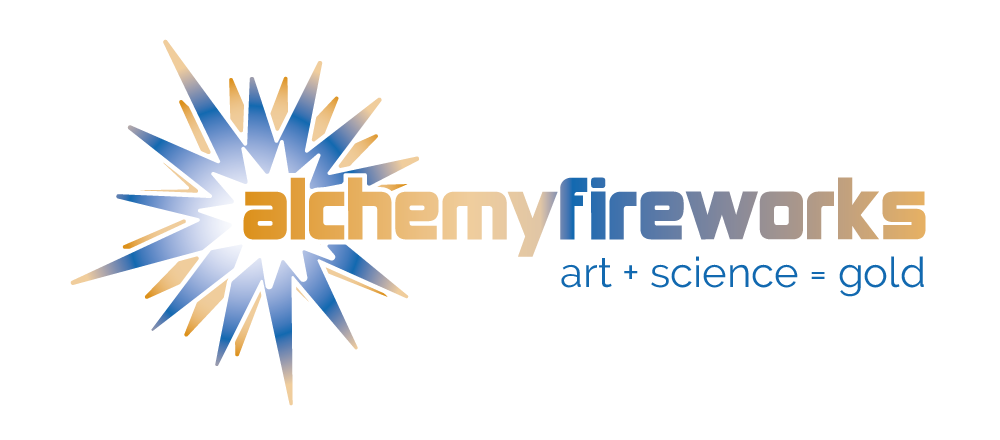Happy Birthday Alchemy Fireworks!
Happy Birthday to Alchemy Fireworks! 9 years young today. Thanks to everyone involved in our successful journey so far 🎉💥🎁

Happy Birthday to Alchemy Fireworks! 9 years young today. Thanks to everyone involved in our successful journey so far 🎉💥🎁

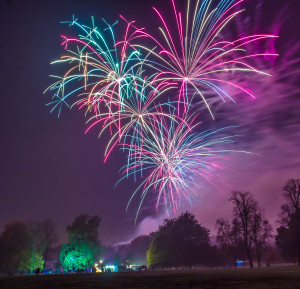
A traditional part of celebrations around the world, very few things beat an innovative and magnificent fireworks display. Creating fireworks with distinct and bright colours needed for an impressive display relies on precise chemistry and a great application of scientific principles. The points of light projected from fireworks, often known as stars; usually require fuel, a binder to keep everything in the correct place and an oxygen-producer, along with the colour producer to determine the look of the firework.
There are two main ways to produce colour in fireworks, luminescence and incandescence.
Luminescence
Luminescence is light produced through energy sources other than heat, and is sometimes known as ‘cold light’. This is due to luminescence’s ability to occur at room temperature or even cooler temperatures.
Luminescence is produced through energy being absorbed by an electron of a molecule or atom, causing it to be unstable and excited. This energy is released when the electron returns to a lower energy state, releasing in the form of a photon, or light. It’s this photon that determines the colour or wavelength of a firework.
The salts used in the production of luminescent fireworks can be unstable. For example, barium chloride, used in the production of green fireworks, is unstable at room temperature and must be combined with more stable compounds such as chlorinated rubber.
Copper chloride, responsible for blue fireworks, is unstable at higher temperatures, meaning that a blue firework cannot get too hot, despite needing to be bright enough to be seen.
Incandescence
Incandescence refers to light produced from heat. It works by causing a substance to become hot and eventually glow. Initially emitting infra-red light, incandescence soon emits red, orange, yellow and ultimately white light as the temperature increases.
By controlling the temperature of a firework, it’s possible to manipulate the glow of the components to produce the desired colour at the right time. Various metals are useful for creating brightly burning fireworks as they increase the temperature of the firework, such as aluminium, magnesium and titanium.
The quality of firework colours
In order to produce pure colours, at Alchemy Fireworks, we use pure ingredients. Different colours can be overpowered or altered by trace amounts of sodium impurities, resulting in a yellow-orange colour.
We also carefully formulate our fireworks so that the colour of the firework isn’t masked by too much residue or smoke, ensuring a bright and colourful display.
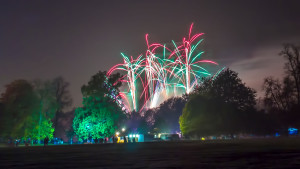
The elements used in creating firework colours:
Aluminium
A common component of sparklers, aluminium is used to produce white and silver sparks and flames.
Antimony
Antimony is often used to create glitter effects for fireworks.
Barium
Barium is involved in the production of green fireworks and can stabilise some other volatile elements involved in fireworks production.
Calcium
Calcium is regularly used to deepen a variety of different firework colours. Calcium salts are also used to create orange fireworks.
Copper
Copper compounds are often used due to their ability to produce blue colours in fireworks.
Lithium
Lithium is responsible for producing red colours in fireworks. One of the most common fireworks colourants is lithium carbonate.
Magnesium
Magnesium is used to improve the brilliance of a firework or to add white sparks, due to it burning a very bright white.
Phosphorous
As well as potentially being a component in the fuel of a firework, phosphorous burns instantly in the air and is used for some glow-in-the-dark effects.
Sodium
Sodium is used for giving a bright gold or yellow colour to fireworks; however the brightness of the burn can easily overshadow other colours.
Strontium
Like lithium, strontium is used to produce red colours in fireworks. It’s also important in stabilising a variety of more volatile firework mixtures.
Titanium
Burnt as either powder or flakes, titanium metal is used to produce silver sparks.
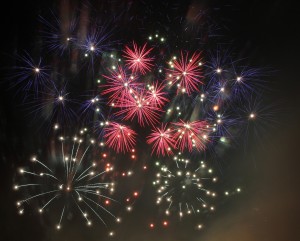
Why not try creating different coloured flames yourself?
If you want to experience how different chemicals react to heat and create different colours, you can easily make a small campfire and sprinkle chemicals over it.
Not only can you buy specially produced packets of chemicals for colouring flames, you can quite easily make them yourself. If you’re going to cook food on your fire, it’s advisable to do this before you add the chemicals to reduce the risk of contamination. The following chemicals aren’t very toxic, producing no dangerous smoke or harm to the surrounding area.
For white flames, use magnesium sulphate, commonly found in Epsom salt. Yellow flames can be produced from sodium chloride, also known as table salt. If you want to create green flames, use borax- a common ingredient in cockroach powder or the disinfectant, boric acid powder. You can also create green flames through using copper sulphate, or algae treatment.
Copper chloride can be used to create blue flames, and purple flames can be produced through the use of potassium chloride or a salt substitute. If you’d prefer pink flames, lithium chloride or lithium from a battery will work.
Whilst fires tend to be red and orange in colour naturally, to create red flames, you can find strontium nitrate and strontium chloride in emergency road flares. Orange flames can be made incredibly easily using iron oxide, or rust.
A lot of these chemicals can be bought at a supermarket, and the ones you can’t find there are easily available online. You may wish to avoid using sodium chloride for yellow flame. Not only do flames appear yellow, the sodium chloride can easily overpower any other colours you’re trying to make.
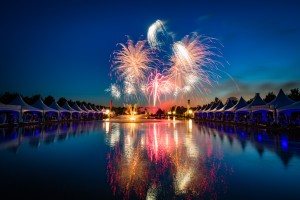
At Alchemy Fireworks, we regularly undertake fireworks displays to meet every budget, size, shape and brief. From corporate celebrations to large public Bonfire Night displays, the team at Alchemy Fireworks ensure that your event brings the fun and excitement you want, to your event.
If you’re not sure what you want from your fireworks display, our experienced and professional team are on hand to take you through our winning formula for designing a unique display to amaze and thrill your guests.
Call us now on +44 (0)8000 66 58 37 to discuss your firework display plan and see how we can make your dream a reality.
It may have been wet, wet, wet this weekend but thanks to our expert waterproofing which happens back at Alchemy Fireworks HQ the fireworks stay nice and dry right up until the moment they’re fired. Our displays are pre-waterproofed so the fireworks arrive on site ready for whatever the worst of the British weather can throw at them. And often that means hours, sometimes days, of rain. We invest in good quality waterproofing material ensuring that even in continuous torrential downpours you can rest assured that the show will still go on!
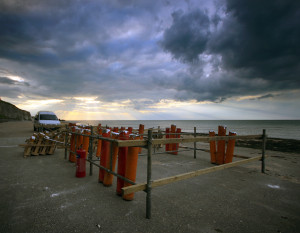
Fireworks rigged and the weather looking gloomy!
“Remember, Remember the fifth of November,
Gunpowder treason and plot.”
Born in 1570 in the city of York, Guy Fawkes has been immortalised for his role in the 1605 Gunpowder Plot. Even today, Guy Fawkes is a prominent feature of any Bonfire Night celebration. So who was Guy Fawkes and what are the facts behind this enduring Bonfire Night myth?
Guy Fawkes’ family
Guy Fawkes’ immediate family were all Protestant, although his maternal grandparents were ‘recusant’ Catholics, refusing to attend Protestant church services. When he was eight, his father died before his mother remarried a Catholic man called Dionis Baynbrigge.
The influence of his grandparents and Dionis would help to cement Guy Fawkes’ fanatical Catholic faith in later years.
Guy Fawkes’ time in Spain
Guy Fawkes was 21 when he sold the estate left to him by his late father to go to Europe and fight for Catholic Spain in the Eighty Years War against the Protestant Dutch republic. He flourished in the military atmosphere and by 1603m he was recommended for a captaincy.
It was also around this time he started to use the Italian variant of his name, ‘Guido’.
Later in 1603, Guy Fawkes’ went to petition the Spanish Philip III to support a rebellion in England against the Protestant James I. Philip refused, even though Spain was technically at war with England at the time.
Guy Fawkes and the Gunpowder Plot
Whilst fighting for Spain in Flanders, Guy Fawkes met Thomas Wintour, who invited Fawkes to join the Gunpowder Plot under the leadership of Robert Catesby.
Due to Guy’s experience with gunpowder, he was given the essential, but highly dangerous role of sourcing and igniting the explosive.
But eighteen months of meticulous planning was ultimate for nothing, when he was found with just hours to go, amongst barrels of gunpowder and arrested. The thirty-six barrels of gunpowder had been placed directly under the House of Lords where the king would sit for opening the House of Lords the next day.
James I’s spymaster, Robert Cecil, had brilliantly engineered the foiling of the gunpowder plot. Torture was technically illegal at the time, but the king personally gave out a licence for Fawkes to be tortured, including the rack.
Whilst the threat alone of torture was usually enough to gain answers, Guy Fawkes endured two full days before he confessed anything. His famous signature on his confession shows that he was barely able to hold a quill by the end of his ordeal.
James I was impressed with Guy Fawkes high level of fortitude throughout his arrest and torture, admiring his “Roman resolution”.
Hung, drawn and quartered
Guy Fawkes was sentenced to the traditional traitors’ death of being hung, drawn and quartered on the 31st January 1606.
To avoid being drawn (dragged) and quartered, he jumped as he was hung, breaking his own neck. Parts of his body were still quartered and sent to the four corners of England as a warning to other would-be traitors.
Fawkes was 35 when he died at Westminster.
The legacy of Guy Fawkes
Instantly, Guy Fawkes became a national ‘bogeyman’ and was seen as the embodiment of Catholic extremism. He served as a pretext for the additional repression of Catholics, measured that would persist for another 200 years.
Whilst the charismatic Robert Catesby was the ringleader of the gunpowder plot, it isn’t surprising that we mainly remember Fawkes.
Catesby was killed evading capture and was never tried, whereas Fawkes was the man to get caught red-handed under the Houses of Parliament, resolved not to speak under torture and was publicly executed.
Bonfire Night, Fireworks and The Guy
The first 5th of November bonfires began the same year as the Gunpowder Plot itself. After Guy Fawkes was arrested in the early hours between the 4th and 5th November, joyful Londoners began lighting fires for their king’s safety on the night of the 5th. As the years went on, the traditions of Bonfire Night became increasingly elaborate.
Beautiful and complex fireworks displays were added, along with burning effigies of Guy Fawkes (and sometime the Pope) on the bonfires. Even today, some bonfire celebrations will throw an effigy of Guy Fawkes, the Pope and even current politicians as a quirky celebration, rather than being a sign of hostility against Catholic Church.
Penny for the Guy?
Making a dummy or effigy of Guy Fawkes, known as the Guy, is an integral part of celebrating Bonfire Night. Children still sometimes walk through the streets with the effigy, asking for ‘a penny for the Guy’. This money was traditionally used to buy fireworks for the night’s festivities.
Bonfire Night in Britain add Beyond
Not only is Bonfire Night celebrated in Britain, it’s celebrated in other parts of the world. During the time of the British Empire, it quickly found popularity in a number of colonies. New England in the United States celebrated it as Pope Day well into the 18th century. Newfoundland in Canada and New Zealand still light bonfires on the 5th November, along with their British counterparts.
If you’re looking to host a Bonfire Night to be remembered, contact us now to start organising your fireworks display, lancework and firerope and even lighting and lasers, or call 0800 0665 837.
In amongst the few displays that happen at this time of year we’re always busy beavering away at little projects that get side-lined when we’re busier. It’s at this time of year that orders get placed with suppliers (and we’ve got some amazing new firework effects already lined up for this year!), we maintain and build new hardware for use in fireworks displays, carry out a stock take and a good tidy up of our stores. This week we’re taking delivery of our new van and waving goodbye to our old stalwart of a van that’s been with us for 6 years. We’ve also just today had 4 bookings for summer displays so we’re far from quiet! A few of us head out to Valencia next week for a bit of a jolly (sometimes it’s nice to just watch fireworks displays and not be working on them!). Each year they have a huge fireworks festival with both daytime and night-time displays. If you’re a fireworks fan and have never been – GO! You will not be disappointed. Wi-Fi permitting we’ll send some reports back from there between displays, siestas and beer!
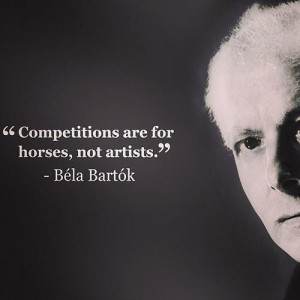 Firework displays are an art form. Like any painting, piece of music or theatre they’re subjective. One man’s meat is another man’s poison so the saying goes! I’ll often watch displays these days and many are truly technically brilliant. The single shots will hit the beats of the music and the shells will all burst on the crescendos. But both software and hardware advances make it easy to achieve that. Now, I don’t know about you but for me those types of shows come across as very robotic. Sure, it’s great to witness and the audience now expects to see that but when it happens all the way through a display and in every sequence I do feel that the display loses any passion as it seemingly goes through the motions. What I think many displays seem to lack at the moment is an element of feeling. That kind of leads me on to fireworks competitions. I recently saw this somewhere online and it kind of rang true for me – at the moment at least!
Firework displays are an art form. Like any painting, piece of music or theatre they’re subjective. One man’s meat is another man’s poison so the saying goes! I’ll often watch displays these days and many are truly technically brilliant. The single shots will hit the beats of the music and the shells will all burst on the crescendos. But both software and hardware advances make it easy to achieve that. Now, I don’t know about you but for me those types of shows come across as very robotic. Sure, it’s great to witness and the audience now expects to see that but when it happens all the way through a display and in every sequence I do feel that the display loses any passion as it seemingly goes through the motions. What I think many displays seem to lack at the moment is an element of feeling. That kind of leads me on to fireworks competitions. I recently saw this somewhere online and it kind of rang true for me – at the moment at least!
Today is Chinese New Year and it’s the year of the Monkey. We’d like to wish all our Chinese friends and colleagues around the world a very happy New Year! Fireworks are used to drive away the evil in China. Right after 12:00PM on New Year’s Eve, fireworks will be launched to celebrate the coming of the New Year as well as to drive away the evil. It is believed that the person who launched the first firework of the New Year will obtain good luck. Daylight fireworks are usually very noisy and feature coloured smoke and noise effects. Check out this amazing daytime fireworks show! The colours of the smoke and the noise are just incredible to watch. At one point it looks like a field of tulips. Check out our own (somewhat smaller!) daylight fireworks show for Middlesbrough Mela here.
On Saturday evening we were asked to provide a pyro-musical display for a surprise 30th Birthday in Berkshire. A cold, dry day led to an even colder dry evening and the guests were treated to a stunning display choreographed to specially chosen music. The still pictures above are the result of my first time out with a camera – not bad even if I do say so myself! You can watch a video of this display by clicking this link.
Welcome!
It’s here at last! Welcome to the new Alchemy Fireworks website!
We’re still filling in the gaps with a bit of the content, but subscribe or come back regularly for helpful information on how to organise professional firework displays, our lastest firework display videos and photos, plus interesting articles on topics such as wedding fireworks and the latest firework news. If you have any feedback on the new website please email glenn@alchemyfireworks.co.uk.
We’ve just invested in a new drone to capture some great quality footage of our displays. Check out some video of us testing it over Braughing in Hertfordshire and watch out for it in a sky near you soon!
https://www.youtube.com/watch?v=F4kjzri3R9k
Plus, check out our recent shows featuring the drone footage..
